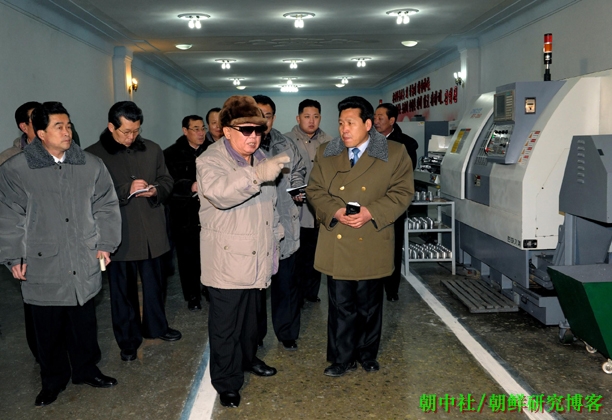The Center’s First Appearances in 2011

North Korean leader Kim Jong-il (C) visits a new glass bottle factory in Nampo, South Pyongan Province. The (North) Korean Central News Agency released the photo on Jan. 14, but did not clarify when it was taken. (KCNA/Yonhap)
Kim Chong-il has made his first public appearances of 2011. On 12 January (Wednesday) the DPRK media reported that he toured the recently constructed Nampo Glass Bottle Factory. On 14 January (Friday) KCNA reported that Kim Chong-il visited three factories in North Pyongan “alive with a new year drive to bring about about a boost in production.” KCNA on KCI’s visit to the Amnokgang Daily Necessities Factory:
He praised the factory for successfully manufacturing an ultra-modern uppers injection-moulding machine badly needed for keeping production going at a high rate at the Hyesan Footwear Factory.
The factory has an important role to play in developing the nation’s daily necessities industry and improving the people’s standard of living, he said, advancing the important tasks to be carried out by the factory.
He set the target for putting major production processes on a CNC basis to be attained by the factory till April 2012, the centenary of birth of President Kim Il Sung, and specified the orientation and ways for hitting it. He showed such great benevolence as unraveling the problems raised.
He was accompanied by Kim Jong Un, vice-chairman of the Central Military Commission of the WPK, Kim Kyong Hui, member of the Political Bureau and department director of the C.C., the WPK, Pak To Chun and Kim Phyong Hae, alternate members of the Political Bureau and secretaries of the C.C., the WPK, and Ju Kyu Chang, alternate member of the Political Bureau and department director of the C.C., the WPK.

Kim Chong-il tours the Amnokgang Gauge and Instrument General Factory in Orth Pyongang (Photo: KCNA)
The youthful general, Kim Chong-un, was not reported to have attended the earlier visit to the Nampo Glass Bottle Factory. Interestingly, Chang Song-taek was reported as having attended neither visit.
Meanwhile, the DPRK has announced its “10-Year State Strategy Plan for Economic Development.” Yonhap reports:
The North’s state-run Korean Central News Agency (KCNA) said Saturday the North Korean Cabinet decided to adopt a “10-Year State Strategy Plan for Economic Development” and to set up a new agency called the State General Bureau for Economic Development.
“This governmental body will handle all issues arising in implementing state strategy projects for economic development,” the KCNA’s English-language report read. “The above-said plan set a state strategic goal for economic development. It puts main emphasis on building infrastructure and developing agriculture and basic industries including electric power, coal, oil and metal industries and regional development.”
North Korea has set out to become a “strong and prosperous state” by the year 2012, which marks the 100th anniversary of the birth of Kim Il-sung, founder of North Korea and father of the current leader, Kim Jong-il. The KCNA said the 10-year plan will help the North achieve the stated goal by next year and also put the country among advanced economies by 2020.
“When the above-said strategy plan is fulfilled, the DPRK will emerge not only a full-fledged thriving nation but take a strategic position in Northeast Asia and international economic relations,” the report said, referring to the North by its official name, the Democratic People’s Republic of Korea.
Cho Bong-hyun, a Seoul-based analyst with IBK Bank, said North Korea had been working on the 10-year plan since late 2009 and that it covers 12 areas worth US$100 billion.
According to Cho, the dozen categories include agricultural development, the building of five logistics districts, an airport and a port, and urban development.
“Setting up this 10-year plan is to help find breakthroughs for the North Korean economy through foreign investments, since the North has reached a point where it can’t solve economic problems on its own,” Cho observed.
The analyst also said the North’s current regime appears to be trying to build economic achievements credited to Kim Jong-un, the heir apparent to Kim Jong-il, and smooth the impending hereditary power succession.


